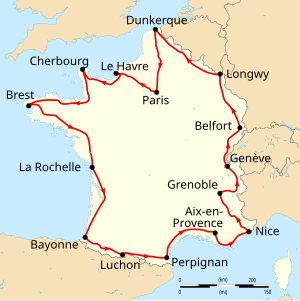1913 Tour de France

Route of the 1913 Tour de France
Followed counterclockwise, starting in Paris |
|||||||||||||
| Race details | |||||||||||||
|---|---|---|---|---|---|---|---|---|---|---|---|---|---|
| Dates | 29 June – 27 July | ||||||||||||
| Stages | 15 | ||||||||||||
| Distance | 5,287 km (3,285 mi) | ||||||||||||
| Winning time | 197h 54' 00" | ||||||||||||
| Results | |||||||||||||
|
|||||||||||||
| Winner |
|
(Peugeot) | |
| Second |
|
(Peugeot) | |
| Third |
|
(Peugeot) |
The 1913 Tour de France was the 11th edition of the Tour de France, taking place between 29 June and 27 July. The total distance was 5,287 kilometres (3,285 mi) and the average speed of the riders was 26.715 kilometres per hour (16.600 mph). The competition was won by the Belgian Philippe Thys, after in the crucial sixth stage Eugène Christophe broke his bicycle and lost several hours because he had to do the repairs by himself. In the last stage, Thys also had mechanical problems, but he got help during the repairs, and only got a penalty of ten minutes.
Between 1904 and 1912, the overall classification had been calculated by points, but in 1913 the classification was reverted to the original format from 1903, where the overall classification was calculated by adding up the times of the individual stages. The general classification has been calculated in the time format ever since.
In 1905, the format of the Tour de France had been changed from the time system to the points system, to reduce the cheating that had caused the first four cyclists of the 1904 Tour de France to be disqualified. In the 1912 Tour de France, this system had been working against Eugène Christophe's chances, who would have been leading the time classification up until the final stage where he allowed a group to ride away. The system had been working against a French cyclist and in favor of a Belgian cyclist (Odiel Defraye, who won the Tour de France in 1912), and the French organisation changed the system back again to the time system: the finishing times of all stages were added per cyclist, and the cyclist with the least total time was the winner. This was also intended to increase combativity, because in the points system riders did not care about time gaps, so escaped low-ranked riders were ignored by high-ranked cyclists.
For the first time, the route of the race was in the opposite direction. Prior to the 1913 race, the Tour the France always had been in the clockwise direction through France, and in 1913 it was anticlockwise.
The 1913 Tour started with 140 cyclists; there were 51 cyclists distributed over 9 teams, including all favourites for the overall victory. The remaining 89 cyclists started in the isolés category. This edition started with six former Tour de France winners (Louis Trousselier, Lucien Petit-Breton, François Faber, Octave Lapize, Gustave Garrigou and Odile Defraye), the most ever.
...
Wikipedia
